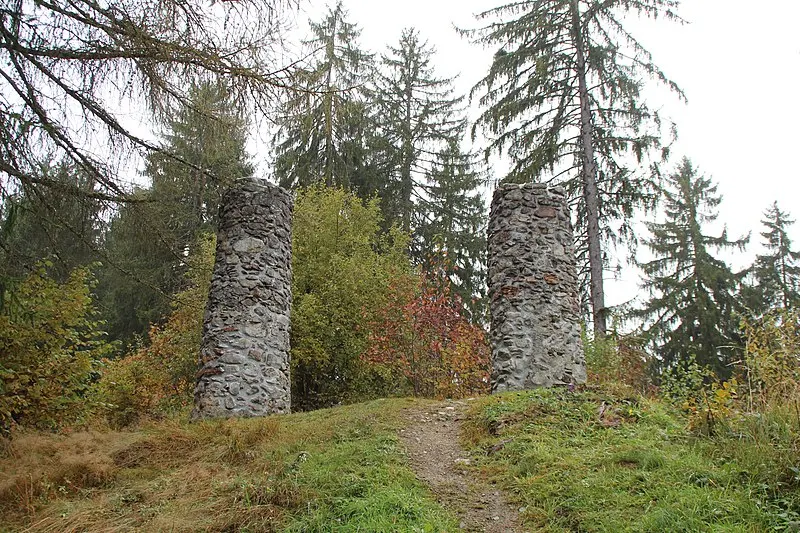Jörgenberg Castle is a castle in the municipality of Waltensburg/ Wurz in the canton of Graubünden in Switzerland. It is a Swiss monument of national importance.
 |
| Jörgenberg Castle |
Jörgenberg Castle was built in the 8th century as a fortified church on land donated by the Frankish kings. In the will of Bishop Tello in 765, it is mentioned as a castle on the Jörgenberg hill. At the beginning of the 9th century it was called ecclesia sancti Georgii in Castello or the Church of St. George in the castle. The current castle and church were probably built on the site of a previously walled church. The logs in the bell tower were dated to 1070. In the following centuries, the church was transformed into a medieval feudal castle, and in 1265 the main tower was completed.
 |
| Jörgenberg Castle |
In the 14th century, the castle is mentioned in historical records in the possession of Freiherr von Fry (i) berg, who were vassals of the powerful Vaz family. In 1333, a coalition of religious and secular lords fought against the Vaz and their vassals, including the Freibergs. Both Jörgenberg and the nearby village and castle of Siat were captured by the coalition. The peace treaty of 1333 brought the castles back, but Freiherr von Rhäzüns had some claim to this.
However, a few years later, the last member of the Vaz family, Donath, died, leaving the Freibergs without an influential patron. In order not to lose their possessions, they sold Siat and Jörgenberg to the dukes of Austria, and then returned them as a feudal possession.... In 1342, the last male heir to the Friberg family, Reinher, died and the Austrians handed over the castle to the Counts of Werdenberg. Freiger von Rezüns demanded locks on the basis of his claim from 1333 and began to attack the Austrians in the region. During the fighting, the main tower burned down. The peace treaty of 1343 handed over the fate of the castle to the arbiter, who handed over the castle to Rezuns.
 |
| Jörgenberg Castle |
From about 1351, the Rezuns family rebuilt the burnt tower and added a palace in the northwest corner. In 1378 they bought the nearby Herrschaft and merged them into the Herrschaft of Jörgenberg. They appointed vogts to rule the herrschaft for the next century. In 1458, Jörgenberg passed to the Counts von Zollern. Local farmers and villagers disliked foreign Swabian Zollerns and refused to honor them and often rebelled. A little over ten years later, in 1472, the Zollerns got rid of the troubled province by selling it to the Abbot of Disentis Abbey... Under the abbot, the castle remained the administrative and judicial center of the herrschaft.
A pair of stone gibbet pillars were built near the castle. In 1539, the Protestant Reformation swept through the territory, destroying much of the abbey's secular and judicial power and forcing the abbey to sell Jörgenberg to Matthias Rung von Waltersburg. At the time, the castle and church were still in good condition. In 1580, Matthias Rung sold the castle to L. Gundreye, whose family had owned it for over a century. In the 17th century, it was abandoned and began to deteriorate. In 1705, they sold the ruins to the municipality. In 1734, the Abbot of Disentis transferred all his rights to Waltenberg, but retained the title of Lord Jörgenberg.
In 1931-32, the ruins of the castle were excavated, cleaned and fortified. In 1998-2001 it was renovated again.
